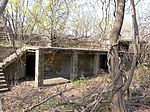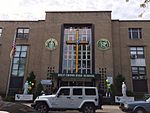Bay Terrace, Queens

Bay Terrace is a neighborhood in the northeastern section of the New York City borough of Queens. It is often considered part of the larger area of Bayside. Bay Terrace overlooks the East River and the approaches to the Throgs Neck Bridge from the Clearview Expressway and Cross Island Parkway. It is bounded on the west by the Clearview Expressway, on the south by 26th and 28th Avenues, to the east by the Little Neck Bay, and to the north by the East River. Bay Terrace is located in Queens Community District 7 and its ZIP Code is 11360. It is patrolled by the New York City Police Department's 109th Precinct. Politically, Bay Terrace is represented by the New York City Council's 19th District.
Excerpt from the Wikipedia article Bay Terrace, Queens (License: CC BY-SA 3.0, Authors, Images).Bay Terrace, Queens
18th Avenue, New York Queens County
Geographical coordinates (GPS) Address Nearby Places Show on map
Geographical coordinates (GPS)
| Latitude | Longitude |
|---|---|
| N 40.783 ° | E -73.781 ° |
Address
18th Avenue 211-53
11360 New York, Queens County
New York, United States
Open on Google Maps




